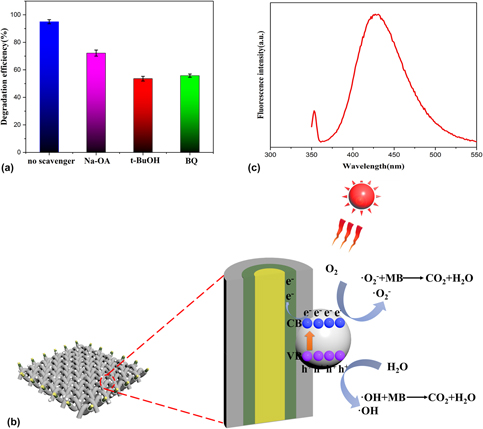Crossref Citations
This article has been cited by the following publications. This list is generated based on data provided by
Crossref.
Wu, Shizi
Xie, Yao
Zhang, Xianmei
Huang, Zhaohui
Liu, Yangai
Fang, Minghao
Wu, Xiaowen
and
Min, Xin
2019.
In situ synthesis of adsorptive β-Bi2O3/BiOBr photocatalyst with enhanced degradation efficiency.
Journal of Materials Research,
Vol. 34,
Issue. 20,
p.
3450.
Stejskal, Jaroslav
2020.
Interaction of conducting polymers, polyaniline and polypyrrole, with organic dyes: polymer morphology control, dye adsorption and photocatalytic decomposition.
Chemical Papers,
Vol. 74,
Issue. 1,
p.
1.
Chang, Peng
Mei, Hui
Tan, Yuanfu
Zhao, Yu
Huang, Weizhao
and
Cheng, Laifei
2020.
A 3D-printed stretchable structural supercapacitor with active stretchability/flexibility and remarkable volumetric capacitance.
Journal of Materials Chemistry A,
Vol. 8,
Issue. 27,
p.
13646.
Shuai, Huan
Wang, Yuxin
Wang, Jiao
Du, Gaoxiang
Chen, Daimei
and
Liang, Yu
2021.
Preparation of TiO2/Black Talc Composite Photocatalyst and the Research on Its Adsorption-Degradation Coupling Effects.
Materials,
Vol. 14,
Issue. 20,
p.
6038.
Shuai, Huan
Wang, Jiao
Wang, Xianguang
and
Du, Gaoxiang
2021.
Black Talc-Based TiO2/ZnO Composite for Enhanced UV-Vis Photocatalysis Performance.
Materials,
Vol. 14,
Issue. 21,
p.
6474.
Duan, Yonghua
Gou, Ming-Lei
Guo, Yafei
Cai, Junqing
Song, Wensheng
Liu, Zhen
and
Zhou, Erpeng
2021.
In situ hydrothermal synthesis of TiO2–RGO nanocomposites for 4-nitrophenol degradation under sunlight irradiation.
Journal of Materials Research,
Vol. 36,
Issue. 4,
p.
906.
Xie, Yan
Wang, Jiao
Ren, Fengguo
Shuai, Huan
and
Du, Gaoxiang
2022.
Nonmetallic Mineral as the Carrier of TiO2 Photocatalyst: A Review.
Frontiers in Catalysis,
Vol. 2,
Issue. ,
Gunduz, Hatice
Karslioglu, Ramazan
and
Ozturk, Fahrettin
2022.
Microstructural Evaluation of Graphene-Reinforced Nickel Matrix Ni-P-Gr Coating on Ti-6Al-4V Alloy by the Electroless Coating Method.
Coatings,
Vol. 12,
Issue. 12,
p.
1827.
Turro, Claudia
and
Dressick, Walter J.
2022.
Electroless Metallization of the Elements: Survey and Progress.
ACS Applied Electronic Materials,
Vol. 4,
Issue. 12,
p.
5664.
Saini, Deepika
Dumra, Simran
Kumar, Vishrant
Aggarwal, Ruchi
Naziruddin, Abbas Raja
and
Sonkar, Sumit Kumar
2023.
Magnetic Graphene Nanosheets from Expired Iron-Supplemented Tablets for Hydroxyl-Mediated Photocatalytic Oxidation of Azo Dyes.
ACS Applied Nano Materials,
Vol. 6,
Issue. 3,
p.
1573.
Migdadi, A.B.
Al-Bataineh, Qais M.
Ahmad, Ahmad A.
Al-Khateeb, H.M.
and
Telfah, Ahmad
2024.
Titanium dioxide/reduced graphene oxide nanocomposites as effective photocatalytic for hazardous 4-nitrophenol.
Journal of Alloys and Compounds,
Vol. 971,
Issue. ,
p.
172794.
Dharmalingam, Karthigaimuthu
Gurudevan, Vijayakumar
Dhanasekaran, Gokulnath
Sekar, Deepak
Gopal, Ramalingam
Alshamsi, Dalal
Thangavel, Elangovan
and
Sambasivam, Sangaraju
2024.
Synthesis and characterization of lamellar-like Cu2(OH)3NO3 nanosheets integrated with Mg(OH)2 nanoparticles heterojunction for photocatalytic activity.
Journal of Materials Research,
Vol. 39,
Issue. 2,
p.
231.
Padmaja, Bommu
Dhanapandian, S.
Paramasivam, Prabhu
and
Ayanie, Abinet Gosaye
2025.
Enhanced Solar Photocatalysis: Vapor Pressure Synthesis of Ni‐Doped SnO2 Nanoparticles for Efficient Organic Dye Degradation.
ChemistrySelect,
Vol. 10,
Issue. 12,



